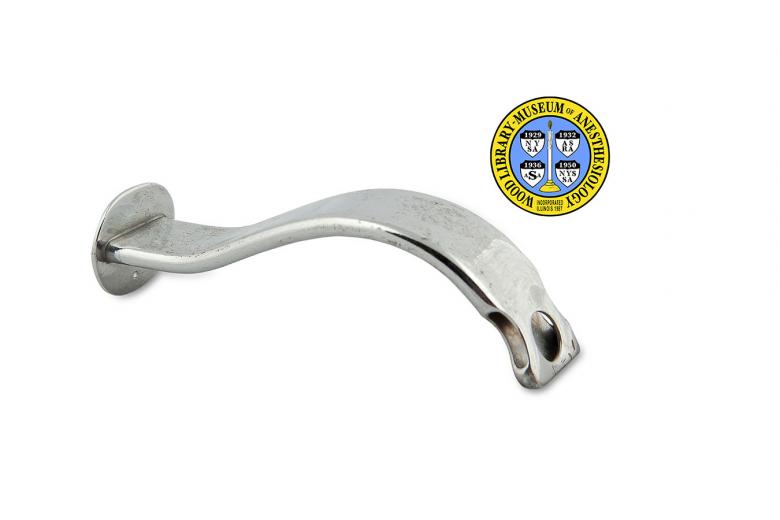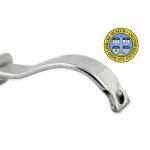Connell Airway
Anesthetics can cause the muscles of the mouth and throat to relax and obstruct breathing. Inserted over the tongue, artificial airways provide a clear passage through which anesthetized patients can breathe. The American surgeon, Dr. Karl Connell (1878-1941) described the one of the earliest oropharyngeal airways in 1913. The oral airways introduced a few years before Connell’s featured a rubber tube, which could be closed off by the patient's bite. The Connell Airway was made of metal to prevent compression. It was shaped to fit the roof of the mouth and the upper throat – an ergonomic design that informed many later airways. The Connell Airway continued to be sold through the 1960s.
Catalog Record: Connell Airway
Access Key: akis
Accession No.: 64-81
Title: [Connell rebreathing tube / Karl Connell.]
Author: Connell, Karl Albert, 1878-1941.
Title variation: Alt Title
Title: Connell airway.
Title variation: Alt Title
Title: Connell pharyngeal re-breathing tube.
Title variation: Alt Title
Title: Connell pharyngeal breathing tube.
Title variation: Alt Title
Title: Connell’s breathing tube.
Title variation: Alt Title
Title: Connell laryngeal tube.
Publisher: [Place of manufacture not indicated] : SJ[?] ; [1914-1950].
Physical Descript: 1 oropharyngeal airway : metal ; 3 x 3.5 x 11 cm.
Subject: Oropharyngeal Airway Devices.
Subject: Airways.
Subject: Airway Management – instrumentation.
Subject: Airway Management Equipment.
Subject: Airway Obstruction – prevention & control.
Note Type: General
Notes: The main title is based on the two earliest publications found that were
written by Dr. Connell and that reference the airway, and the first
advertisement found with the device referenced. In a paper read to the
American Association of Anaesthetists on June 18, 1913, and published in a
supplement of the Annals of Surgery, Dr. Connell states, ” … I desire to
present a new rebreathing tube … .” In an article published in the August,
1913 journal Surgery, Gynecology and Obstetrics on page 252 Connell states, ”
… by the writer’s rebreathing tube.” In an ad by The American Meter Co. in
the December, 1913 issue of Annals of Surgery one of the accessories listed
is a, “Connell pharyngeal re-breathing tube.” The main title could be changed
if documentation indicates it should be corrected.
Note Type: General
Notes: The early date (1914) in the date range for the possible year of manufacture
is based on the year after Dr. Connell had referenced his new airway in at
least two publications. The end date (1950) is based on they time by which
most anesthesiologists are likely to have switched to using other airways,
such as the Guedel. Although the logo or mark of the manufacturer (A large
letter “S” and a smaller letter “J” centrally superimposed within a circle)
is stamped or engraved on the flange of the airway, the name and location of
the manufacturer have not been identified. Also, The first initials and last
name of the previous owner of the airway are hand engraved into the flange of
their airway, “AM MACKAY”, but the individual’s identity has not been further
identified. The date range could change if documentation indicates the range
should be corrected.
Note Type: Citation
Notes: The American Meter Co. Gas meter in surgery [advertisement]. Ann Surg.
December, 1913;58(6):[29th page of unnumbered advertisements at end].
Note Type: Citation
Notes: Coburn RC. The importance and prevention of respiratory restriction during
general anesthesia in inhalation methods. Am J Surg. October,
1913;27(10):361-363.
Note Type: Citation
Notes: Connell K. Accuracy in anaesthesia. Ann Surg. 1913;58(suppl 6):877-890.
Note Type: Citation
Notes: Connell K. An apparatus—Anaesthetometer—for measuring and mixing anaesthetic
and other vapors and gases. Surg Gynecol Obstet. August, 1913;17(2):245-255.
Note Type: Citation
Notes: Connell K Jr. Biography on an inventor: Dr. Karl Connell. [Naples, Fla.]:
Wintoon Waters, [2008]:17-30, 43-56.
Note Type: Citation
Notes: Connell K. Surgical anesthesia. In: Johnson AB, ed. Operative Therapeusis.
New York: D. Appleton and Company; 1915:95,102, 117-117, 122, 129, 136.
Note Type: Citation
Notes: Dr. Karl Connell Exhibit. Anesth Hist Assoc Newsl. 1992;10(2):1-3.
Note Type: Citation
Notes: The Foregger Company. On airways: in memory of Dr. Joseph E. Lumbard.
Anesthesiology. 1943;4(1):i-ii.
Note Type: Citation
Notes: Guedel AE. A nontraumatic pharyngeal airway. JAMA. 1933;100(23):1862.
Note Type: Citation
Notes: Gwathmey JT. Anesthesia. New York: D. Appleton and Company; 1914:119-120, 392
Note Type: Citation
Notes: Haridas RP. The Hewitt airway – the first known artificial oral ‘air-way’ 101
years since its description. Anaesthesia. 2009;64(4):435-438.
Note Type: Citation
Notes: Karl Connell: awards and citations. Military Times Hall of Valor website.
https://projects.militarytimes.com/citations-medals-awards/recipient.
php?recipientid=17393. Accessed August 28, 2013.
Note Type: Citation
Notes: Lumbard JE. A controller of the tongue and palate during general anesthesia.
JAMA. 1915;64(21):1757.
Note Type: Citation
Notes: McIntyre JWR. Oropharyngeal and nasopharyngeal airways: I (1880-1995). Can J
Anaesth. 1996;43(6):629-635.
Note Type: Citation
Notes: Walk RD. Mask history: infantry or general-purpose mask. CML Army Chem Rev.
February, 2001:23-32. https://www.gasmasklexikon.com/Page/USA-Mil-Infantrie.
htm. Accessed August 28, 2013.
Note Type: Physical Description
Notes: 1 oropharyngeal airway made completely of metal; The flange is oval, and
measures approximately 2.6 cm in height and 3.3 cm in width; The air channel,
or oropharyngeal tube, is curved to approximate the anatomy of the mouth and
pharynx, and is flat and wide, measuring approximately 2.4 cm in width, and .
4 cm in height; Measured along the superior curve the air-channel is
approximately 12.5 cm in length; Measured end-to-end the air-channel is
approximately 10.9 cm long; The airway has an open end and three
fenestrations just above the proximal end (from patient’s perspective); A
manufacturer mark is stamped or engraved on the flange; The mark is comprised
of a large letter “S” and a smaller letter “J” centrally superimposed within
a circle; The following text is hand engraved on the flange, “AM MACKAY”; The
airway is marked with numerous scratches, presumable from use; An accession
number is panted on the flange: “64-81”.
Note Type: Reproduction
Notes: Photographed by Mr. Steve Donisch on January 17, 2013.
Note Type: Historical
Notes: Within a few years of Sir Frederic W. Hewitt’s (1857-1916) 1908 introduction
of what is now considered to be the first modern oral airway, a number of
other physicians introduced their own oral airways. Prominent among them was
Dr. Karl A. Connell (1878-1941), a surgeon who introduced the first modern
all-metal oral airway. He described it as a flat curved tube designed to fit
the roof of the mouth, to be easy to insert and to not occlude if bitten on
during anesthesia. Also called oropharyngeal airways, oral airways are tubes
that are inserted into the mouth and upper throat to prevent breathing from
being obstructed when the patient is unconscious.
Dr. Connell was described as a mechanical genius. During his career he
invented a number of anesthesia devices and machines that brought noteworthy
advances to the field of anesthesiology. In fact around the year 1913 alone,
Dr. Connell also introduced a machine called the Anaesthetometer, a gas flow
gauge, and a dual-nasopharyngeal tube. The Connell Oral Airway was popular
for a number of decades. It was eventually replaced by airways of newer
design and material, such as the Guedel Oral Airway of 1933.
Dr. Connell may be best known for the gas mask he created to protect U.S.
soldiers during WWI. Using only the mask as protection, he tested design
modifications by exposing himself to the lethal gasses used by Germans during
the war. Known as the “Connell” or “Victory” mask, it earned him the Army’s
Distinguished Service Medal in 1923.
Note Type: Exhibition
Notes: Chosen for the WLM website (noted July 30, 2013).


